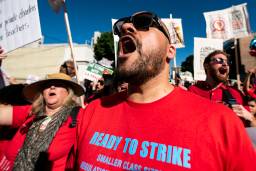When I remember the heroic upsurge in Madison this winter, the subtitle of labor journalist Steve Early’s latest book comes to mind: “The Birth of a New Workers’ Movement or the Death Throes of the Old?” Although Early was speaking of the grandiose promises of the Change to Win union federation, the question can be applied to the massive demonstrations in Madison.
Will the struggle in Wisconsin be seen as the dying gasp of unionism in America, or the turning point marking the construction of a new labor movement? That depends, of course, on the actions of trade unionists in the coming months and years.
The long-awaited hope felt by many regarding the heroic upsurge of working people across Wisconsin threatens to obscure the grim reality facing public sector unionism. In fact, the right’s withering attack on public-sector unionism has been, in large part, successful.
Each day brings another story about an attack on public employee rights. In Michigan, Gov. Rick Snyder used his newly granted powers to impose financial “martial law” in Benton Harbor, Mich., limiting the elected leaders’ power to simply opening meeting. In Oklahoma, city workers lost collective bargaining rights. While unions still have a fighting chance in beating back the attacks in Wisconsin and Ohio, victory is far from certain.
Even in states controlled by Democrats — such as Massachusetts and Hawaii — public employee unionism is under attack. As the Associated Press reported, “As much as they abhor the budgetary solutions offered by many Republican governors, union leaders are finding that the solutions offered by hard-pressed Democratic leaders are often similar in substance, if not in tone.” While public employee unionism will survive this latest attack, it will do so in tatters, with hard-won wage and benefit standards eroded.
The attack on trade unionism is systematic, coordinated, and sustained. As a report in Mother Jones notes, behind this attack is “a well-funded network of conservative think tanks that you’ve probably never heard of.” Funded by anti-labor billionaires such as the Koch brothers and the Coors, this network wants to both destroy union power and dismantle the public sector.
Understanding the deep-seated nature of this attack reveals that there is no such thing as a status quo. Labor’s enemies do not care about budget shortfalls or the education of our children. They want to destroy us. Either the labor movement develops an offensive strategy, capable of confronting capital, or our enemies will systematically hunt down the remaining pockets of trade unionism. Such an offensive strategy must, in the long run, be based in the private sector and be rooted in a powerful strike.
The root of the crisis lies in the private sector
While all eyes are focused on the struggle to preserve unionism in the public sector, the root of the crisis actually lies in the private sector. Specifically, it is rooted in the modern labor movement’s inability to maintain strong wage and benefit standards in the private sector. With union density in the private sector down to 7 percent, unions have negligible impact on the overall wage and benefit structures of major U.S. industries. Defined benefit pensions and zero cost healthcare, once standard in union contracts, are rapidly disappearing for private sector workers.
Thirty years ago, when 78 percent of U.S. workers had defined benefit pension plans, few said public employee pensions were too rich. In fact, the opposite was true, with public-sector workers demanding the hard-won standards established by private-sector unions. When affordable healthcare was the norm, public-sector benefits merely mirrored those achieved in the core unionized sectors of the economy.
Labor’s enemies seized upon this disparity to justify their attack on public sector wages and benefits. As Wisconsin Gov. Scott Walker stated, “We can no longer live in a society where the public employees are the haves and taxpayers who foot the bills are the have-nots.”
Setting aside the obvious irony of Walker attacking modestly compensated public employees in a day when corporate profits are soaring and executive pay skyrocketing, these arguments have provided cover for the bipartisan attack on public-sector labor standards.
Labor’s enemies have correctly identified the key weakness of the modern labor movement — that modern trade unionism lacks an independent base of power. Lacking the powerful strike of decades past, trade unions are forced to rely on the government to survive. In 2010, for the first time in union history in the United States, a majority of union members were public-sector workers. Even much of private-sector unionism instead relies on public dollars. (For example, the building trades unions are dependent on publicly funded building projects.)
Labor’s retreat into the public sector is understandable. Facing hostile employers in the private sector, unions looking to grow found an easier path in the public sector.
Yet as the latest attacks reveal, it is dangerous for the labor movement to rely on political power, rather than worker self-organization and strike activity. Democratic politicians are fickle allies, ready to abandon unions when they feel it is politically expedient. Moreover, as the Wisconsin Governor Walker and his billionaire sponsors realized, a labor movement concentrated in the public sector is vulnerable to attack.
Finally, to accept that union organization and collective bargaining is something granted by the government rather than a fundamental human right is to admit that it can be taken away.
The necessary power of solidarity
In the end, however, those who find hope in the struggle in Madison are correct. The grassroots activism, broad vision and militancy displayed by the working class in Madison represents the only way forward for the labor movement. What happened in Madison was an upsurge, a mass movement which developed a life of its own. As Dan Clawson pointed out a number of years ago in his book The Next Upsurge, the labor movement has typically grown in spurts.
“Most of the time unions are losing ground; once in a while labor takes off” Clawson writes, “From the mid-1930s on, in the stretch of a little more than a decade, the number of union members increased fourfold.” The struggle in Madison reveals the explosive power of solidarity — in working people coming together across industries united in broad based opposition to corporatization of the economy.
True solidarity and mass upsurges are rooted in the grassroots. For decades, the labor movement has favored tightly choreographed corporate campaigns, led by union staffers. But the great upsurges of labor history — the drive to form the CIO in the 1930s and the Civil Rights movement-fueled public employee unionism drive of the late 1960s — were mass movements led by workers which spiraled out of anyone’s control. Four hundred thousand workers engaged in sit-down strikes in 1937 alone, for example, in a wave of worker self-activity which shook the corridors of power.
We got a taste of that in Madison. Although I had left the Twin Cities early one Saturday morning, I was disappointed to arrive in Madison right when the official union rally was ending. Then I realized this was unlike union struggle I had ever participated in. Tens of thousands of workers, arriving alone or in small groups, carrying their creative homemade signs, kept arriving at the capitol. Starting and ending times of the official rallies did not matter. Working people were on the move.
Fueling the rebellion in Madison, we must not forget, was a strike — a refusal to work that is now estimated to include two thirds of Madison teachers. At great personal risk, Wisconsin teachers, believing that caring for students meant standing up for education, chose to engage in what many called a personal protest day. During the critical first week, they provided the sheer numbers and escalation that galvanized the labor movement.
Later, the spotlight would shift to the Wisconsin 14, the Democratic Senators who fled to Illinois rather than participate in the farce that democracy in Wisconsin had degenerated into.
But in the beginning, it was teachers leading the way.
While in the short-term, the labor movement will be focused on defending the public sector, resolving labor’s crisis demands radically different ways of doing things. The strategies of the last two decades — organizing shop by shop, electing Democrats and even corporate campaigns — have proven unable to stem capital’s assault on working people.
Only by breaking through the legal and ideological straitjackets embedded in modern labor law — and reviving true solidarity — can the labor movement regain strength and once again challenge corporate control of our economic and political system.
Joe Burns, a former local union president active in strike solidarity, is a labor negotiator and attorney. He is the author of the book Reviving the Strike: How Working People Can Regain Power and Transform America (IG Publishing, 2011).








